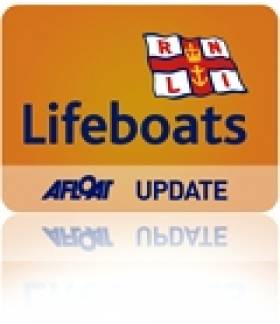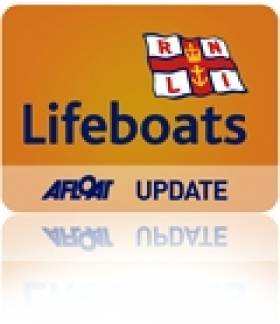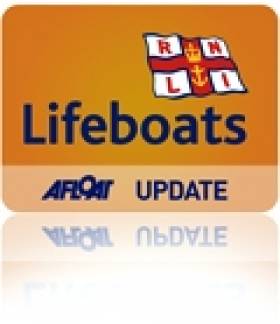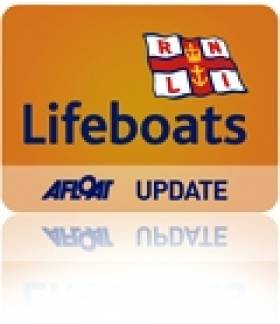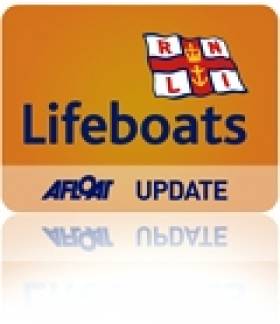Displaying items by tag: Wicklow
Wicklow Lifeboat Attends Fishing Boat With Engine Failure
#RNLI - Wicklow RNLI's all-weather lifeboat launched shortly before 4pm yesterday afternoon (Wednesday 19 February) to assist a fishing vessel in difficulties off Wicklow Head.
The skipper of the fishing vessel contacted the Irish Coast Guard for assistance after his vessel developed engine failure in a position east of Wicklow Head.
The lifeboat, under the command of coxswain Dave O'Leary, located the fishing vessel twenty-five minutes after launching.
Weather conditions in the area were described as wind direction south easterly, force six to seven with a three metre swell.
A towline was quickly established, but progress with the tow was slow returning back to Wicklow due to wind and tidal conditions.
The fishing vessel with three crew was finally secured safely alongside the Packet pier at Wicklow Harbour at 7.45pm.
Lifeboat crew on the callout were coxswain Dave O'Leary, mechanic Brenda Copeland, Carol Flahive, Brian Sinnott, Tommy Murphy and John Vize.
Smiles All Round For RNLI In SOS Day Fundraisers
#RNLI - Wicklow RNLI was delighted to welcome members of the Wicklow Kilmantin Arts Group, who presented a cheque for €500 to the station last Friday (31 January).
The money was raised during a recent art auction in Wicklow, and the local artists' group wanted some of the proceeds to go to a local charity.
Mary De Courcy, chairperson of the fundraising branch, accepted the generous donation on behalf of the station.
Speaking after the presentation, Wicklow RNLI volunteer lifeboat press officer Tommy Dover said the station was delighted to receive the gift "especially on SOS Day, one of the RNLI’s main fundraising days."
SOS Day is the annual RNLI crew fundraising day and stations all over the country host innovative and novel ways of fundraising incorporating the SOS initials.
In Northern Irelabd, supporters of Portrush Lifeboat Station jumped into the sea at Portrush Harbour and swam round the station's all-weather lifeboat, the William Gordon Burr.
The weather was bitterly cold but didn’t deter the crowd that turned up to do their bit.
- RNLI coxswain Des Austin explained: "This is a fun event that involves our crew, fundraisers, and a great local crowd who turn out irrespective of the weather to support the volunteer lifeboat crew.
"The crew themselves take part and their colleagues and on standby to give them a friendly push and also to haul them in at the end of the swim."
The man with the megaphone for the event was Robin Cardwell, Portrush RNLI lifeboat operations manager. All swimmers were counted out and counted back in again.
The crew thanked Coleraine Borough Council for their use of Waterworld for everyone to get a hot shower after their swim, as well as the RNLI lifeguards and the local coastguard team, who provided safety cover for the event.
After the event everyone was treated to homemade soup and sandwiches in Portrush Yacht Club, and a special SOS cake made by crew member Claudia McAlpin.
Wicklow Lifeboat's Annual Service of Remembrance
#RNLI - Wicklow RNLI's lifeboat crew held their annual Service of Remembrance on New Year’s Day yesterday.
The ceremony remembers past deceased lifeboat volunteers and all associated with the sea from Wicklow, and began with a short religious prayer conducted by Father Donal Roche, who blessed the flowers and wreaths.
After the blessing, coxswain Nick Keogh and the lifeboat crew took the floral tributes out to sea and placed them on the water.
Wicklow Lifeboat Aids Fishermen, Courtown Volunteers Recognised
#RNLI - Wicklow RNLI's all-weather lifeboat launched shortly after 12.20pm on Friday 29 November to go to the assistance of a stranded fishing vessel.
The lifeboat crew located a vessel drifting nine miles south east of Wicklow Head after 1pm. The fishing boat, with four crew, had suffered engine failure and was unable to return to port.
The volunteer crew quickly established a towline and the fishing vessel was taken back to Wicklow harbour. It was brought alongside the East pier just before 3pm.
The crew on the callout were coxswain Nick Keogh, mechanic Brendan Copeland, Ciaran Doyle, Brendan Kavanagh, Carol Flahive, Dean Mulvihill and Graham Fitzgerald.
In other lifeboats news, a presentation was made to recently honour many years of service from five Courtown RNLI lifeboat crew members.
Volunteer lifeboat crew members Orla Woods, Nuala Sinnott, Brian Bergin and Paul Woods were all recognised for their many years of dedicated service to the RNLI at an event in Courtown's Taravie Hotel.
Crewmember Fintan O'Donoghue was also presented with a statuette to mark his many years of selfless volunteering.
O'Donoghue is still a very active member of Courtown lifeboat and is now a deputy launch officer and station mechanic.
All Courtown lifeboat crew members are volunteers and give their time freely to save lives at seas.
'Safety Sunday' With Lifeboat Launches In Wicklow And Skerries
#RNLI - Wicklow RNLI went to the assistance of three fishermen whose 36ft fishing boat suffered engine failure near Wicklow Head yesterday afternoon (Sunday 24 November).
The alarm was raised after the crew were unable to start the engine and were concerned about the possibility of their boat being swept ashore.
The Wicklow RNLI all-weather lifeboat launched at 2.30pm under the command of coxswain Ciaran Doyle, followed a few minutes later by the inshore lifeboat.
The drifting fishing vessel was located 10 minutes later about half a mile east of Brides Head. Weather conditions at the time had the wind at a northerly Force 3, with a slight sea state and good visibility.
A towline was quickly established and the stricken vessel was towed back to Wicklow by the lifeboat before 3pm with no further incident.
Much earlier in the day, the Skerries RNLI volunteer crew were tasked to investigate reports of a person in the water in Balbriggan Harbour in the small hours of the morning.
The crew were paged at 12:30am and the lifeboat was launched shortly after with helms Joe May, Conor Walsh and David Knight and crew member Peter Kennedy on board.
There was a Force 3 to 4 northwesterly wind blowing at the time and the sea state was moderate.
The lifeboat proceeded directly to Balbriggan Harbour where it was quickly determined that the person had been taken from the water and was receiving first aid treatment by members of Dublin Fire Brigade and the HSE ambulance service.
The lifeboat then proceeded to carry out a thorough search of the harbour to ensure that there was nobody else in the water before returning to station.
Speaking afterwards, helm Joe May said: "Our volunteer crew are on call 24 hours a day, 365 days of the year. The pager can go off at any time but we are always ready to respond."
End Of An Era At Wicklow Lifeboat Station
#RNLI - It was the end of an era on Friday night 1 November as Wicklow RNLI held a retirement presentation to mark 46 years of service to Wicklow lifeboats by one of its greatest servants, Kit Dunne.
Dunne first became involved with the RNLI way back in 1966. Since then he has served with several different coxswains either as crew or, after taking up the post in 1993, as a deputy launching authority.
Well known in Wicklow Harbour as a pilot, Dunne even came to the aid of the pilot boat when he was aboard the lifeboat JW Archer as a crewman back in 1972.
The 18ft boat had engine failure and with a falling tide was in danger of drifting out to sea when the lifeboat launched to their aid.
Over a period of 27 years, Kit Dunne served the RNLI with distinction. In 1993 he retired from active service but hon secretary Kevin Desmond decided that his common sense experience and loyalty should not be wasted and he was invited to become a deputy launching authority, a position he held until his retirement at the end of last year.
At the retirement presentation, divisional operations manager Owen Medland lauded Dunne's service and dedication over so many years and presented him with a framed certificate of service.
Wicklow RNLI chairman and former coxswain Gerard Haughton also spoke very highly of his time serving with Dunne.
At the very special evening surrounded by family, friends and former colleagues, Dunne was presented with a framed memento of the two lifeboats he had served on, the JW Archer and the Annie Blaker, by Wicklow lifeboat operations manager Des Davitt, who praised him for his outstanding service to his community and the RNLI. He also thanked him for his help and counsel over the last 10 years.
Most important to Dunne was the painting presented to him by his peers. The beautiful artwork, by local artist Pat Dover, was presented by coxswain Nicky Keogh, second coxswain Ciaran Doyle and station mechanic Brendan Copeland on behalf of the crew.
They spoke of the knowledge and experience Dunne has passed down to the new crewmembers over many years. Meanwhile, his son, Kit Jr, told of his pride in his father, who not only served his community but is also a great father and family man.
Kit Dunne thanked all present and told of his great pride in serving such a great organisation as the RNLI. He left the stage to a standing ovation.
In 2005 Dunne was awarded the silver statuette by the RNLI for his service to the institution, but it was clear on the night that he needed no awards or presentations, as his greatest reward was to have served with so many selfless and courageous people over so many years.
Wicklow Lifeboat Launches After Report From Concerned Boater
#RNLI - Wicklow RNLI launched its all-weather lifeboat on Monday evening (23 September) at the request of the Irish Coast Guard following a report of a fishing RIB at sea in darkness.
The alarm was raised at 8.35pm when a member of the public contacted the coastguard after passing a small rigid inflatable boat with two men onboard who were fishing near Wicklow Head. Darkness had fallen and the member of the public was concerned for their safety.
The volunteer lifeboat crew conducted a search of the bay, an illumination flare was fired to light up the search area and night vision equipment was also used.
The crew located the small RIB near Wicklow Head using searchlights at 8.48pm but the two men on board said they did not require assistance, and the all-weather lifeboat was stood down shortly before 9pm.
The lifeboat crew on the call-out were coxswain Nick Keogh, mechanic Brendan Copeland and crew members Tom McAulay, Sean Doyle, Dean Mulvihill, Graham Fitzgerald and John Vize.
Wicklow Lifeboat In Medivac From Survey Vessel
#RNLI - Wicklow RNLI carried out a medical evacuation of an unwell man from a survey vessel off the Wicklow coast in the early hours of yesterday morning (2 September).
The alarm was raised after the man was suspected to have been overcome with fumes on a survey vessel working near the Codling Buoy. The all-weather lifeboat launched at 2.45am and was alongside the survey vessel at 3.12am.
Conditions in the area at the time were described as moderate sea with wind southwest Force 3.
The casualty was transferred onto the lifeboat by stretcher and as the lifeboat returned to Wicklow, the crew administered first aid and monitored the casualty.
Due to the low tide in the harbour at the time, the casualty was transferred to the inshore lifeboat and landed ashore at 3.50am. He was met on arrival by a waiting ambulance crew who took him to hospital.
Speaking after the call-out, Wicklow RNLI lifeboat operations manager Des Davitt said: "This was a typically professional response by the volunteer crew of Wicklow lifeboat, who launched within seven minutes of being paged."
The all-weather lifeboat crew launched under coxswain Nick Keogh with mechanic Brendan Copeland, Ciaran Doyle, Carol Flahive, Paul Sillery, Graham Fitzgerald and Peter McCann on board. The inshore crew were helm Barry Spencer, Dave O'Leary and Brian Sinnott.
Wicklow Lifeboat Launches To Flare Sighting
#RNLI - Wicklow RNLI carried out a search of Wicklow Bay on Saturday night (31 August) after the Irish Coast Guard received a 999 call to report a distress flare sighting.
Both Wicklow's all-weather and inshore lifeboats were requested and launched just before 9pm and a search of the shoreline from the Six Mile Point and bay was conducted.
Conditions in the area at the time presented a calm sea state and there was good visibility.
After an extensive search of the area nothing was found. The lifeboats were stood down and returned to the lifeboat station shortly before 10pm.
Speaking after the call-out, Wicklow RNLI coxswain Nick Keogh said: "We made contact with some anglers on Kiloughter beach and spoke to the crew of a passing yacht in the search area and they hadn't seen anything."
The crew on the inshore lifeboat were helm Graham Fitzgerald, Dean Mulvihill and Peter McCann. The all-weather lifeboat crew were coxswain Nick Keogh, mechanic Tommy Murphy, Ciaran Doyle, Dave O'Leary, Carol Flahive and Brain Sinnott.
Wicklow Lifeboat Aids Troubled Motor Boat
#RNLI - Wicklow RNLI launched its all-weather lifeboat Annie Blaker shortly before 5pm yesterday (29 August) to assist two crew on a small motor boat with engine problems.
The lifeboat was requested to launch by the Irish Coast Guard following a report that a small boat was drifting south of Wicklow Harbour and the occupants appeared to be having difficulties starting the engine.
Speaking after the call-out, Wicklow RNLI press officer Tommy Dover said: "The boat owner succeeded in restarting the engine so the lifeboat escorted the boat with two people safely into Wicklow harbour."
The crew on the callout were coxswain Nick Keogh, mechanic Brendan Copeland and crew members Brian Sinnott, Connie O'Gara, John Vize, Dean Mulvihill and Graham Fitzgerald.




























